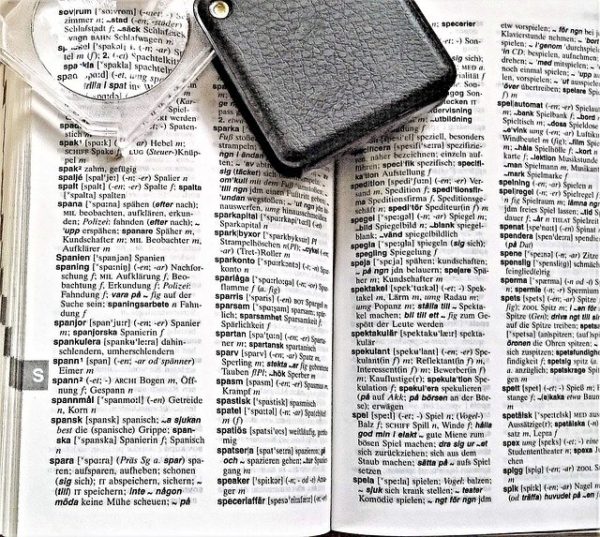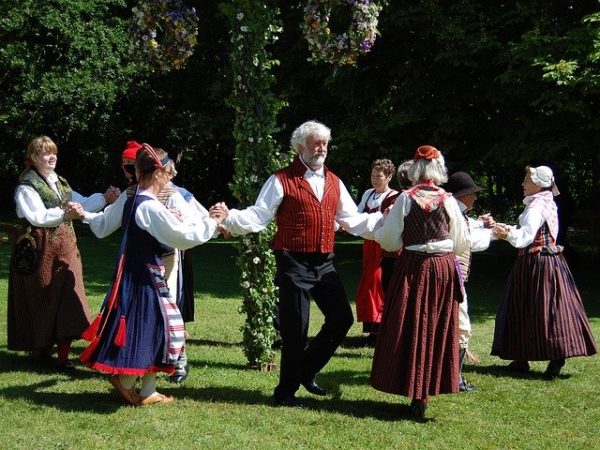The Swedish Language Rocks
Swedish is undoubtedly one of the coolest languages. Why? Because of Swedish people of course. But, really, Swedish is a language worth learning about. Discover the history, grammar, pronunciation, and current use of Swedish. Who knows? Maybe this will be your motivation to start learning Swedish too.
Basic Facts About the Swedish Language
Swedish is the official language of Sweden. There are about 10 million Swedish speakers worldwide. Of these, 8 million speak it natively in Sweden. But, there are also Swedish speaking communities in Finland, Norway, Denmark, and all around the Baltic. In Finland, Swedish is a second official language after Finnish.
Swedish Language Family
Swedish is part of the North Germanic language family. So, this means that it’s related to Danish, Norwegian, Icelandic, and Faroese. However, since it’s a continental Scandinavian language, it’s much closer to Danish and Norwegian than the other two.
Some say that all Nordic languages are actually different dialects of the same language. This is true to some extent, since Danish, Norwegian, Swedish are somewhat mutually intelligible. But, of course, we think of them as different languages.

The History of the Swedish Language
Swedish comes from Proto-Germanic roots. By the 8th century CE, this language diverged into three different branches: West-, East-, and North-Germanic. The latter is were Swedish originates from.
North-Germanic turned into Old Norse, the language of the Vikings. After this language splitting into Insular (Icelandic, Faroese) and continental (Swedish, Danish), we almost arrive at the point where Swedish is its own language. That’s a lot of evolution for a language origin.
Throughout its early history, Swedish was called Runic Swedish. That’s because it was written with runes. Perhaps these may be familiar from typical Viking writings.
Old Swedish
When Sweden became a Christian state in 1225, it adopted the Latin alphabet. This is the start of the Old Swedish period. One of the most significant influences on the language in this period came from the Hanseatic League.
The Hanseatic League was a trading federation. Low-German speaking communities spread across the Baltic and Scandinavia on the Hansa trading route. And this included Sweden. So, thanks to these communities, Low-German was a major influence on the Old Swedish language. You could say the German vocabulary was also … traded. Ba dum tss.
Transition Between Old and Modern Swedish
As the Swedish language developed, its grammar became simpler. Originally, there were four cases, but these reduced to just two. Three genders became two as they merged. And the verb system also became less complex.
Modern Swedish
The publication of the first Swedish Bible in the 16th century marked the beginning of Modern Swedish. Thanks to this Bible Swedish writing became standardized. During the 19th and 20th centuries, more of the language became standardized. Thanks to migrations withing Sweden, dialectal differences disappeared. By the time the 1906 Swedish Spelling Reform happened, the language was really similar to how we know it today.

Swedish Dialects
Generally, standard Swedish is the most widely spoken. There are still regional dialects thanks to the sheer size of the country. But, these dialects are not much different from each other. The only recognizable difference is just the accent. So, everybody understands each other fine in Sweden and in Swedish communities outside the country.
The Swedish Alphabet
The Swedish alphabet has 29 letters. 26 of these are the usual Latin letter we all know in English. Plus, Swedish added 3 extra letters. These are Å, Ä, and Ö. Although these look like variations of A and O, they’re separate letters in their own right.
A a |
B b |
C c |
D d |
E e |
F f |
G g |
H h |
I i |
J j |
K k |
L l |
M m |
N n |
O o |
P p |
Q q |
R r |
S s |
T t |
U u |
V v |
W w |
X x |
Y y |
Z z |
Å å |
Ä ä |
Ö ö |
Swedish Vowels
There are nine vowels in Swedish. Each one has two different ways you can pronounce it: long or short. Vowels are short before a long consonant (two or more consonants together). And vowels are long before a short consonant (one consonants), before another vowel, or at the end of a word.
- A: long like father, short like must
- Å: like home, without the glide
- Ä: long like air, short like get
- E: long like plane, short like get
- I: long like meet, short like bit
- O: long like food, short like good
- Ö: long like the German shön, short like French le
- U: long like food, short like ultra
- Y: long like “eey”, short like “ey”
Swedish Consonants
There are 20 consonants in the Swedish language. Although most of them are the same as English, there are a few important pronunciation differences that you need to know of.
- C = “s” before e, i, and y. Everywhere else C = “k”
- G is always hard like get, never soft like gem. Before e, i, y, ä, or ö G = “y” (like yes)
- D, T, N are all pronounced with your tongue pressed against your top teeth
- J = “y” (like yes)
- K = “sh” before e, i, y, ä, ö. Before a, o, å, u, K = “k” (like kind)
- R is rolled, like in Spanish
- S = “s”, it’s never “z” like in has

Swedish Digraphs
Digraphs are consonant combinations that represent one sound. So, even though you see two separate letters, you only have to say one sound when you pronounce them. Swedish has digraphs and trigraphs (same thing but with three letters instead of two). Once you know these letter combinations, you can easily master Swedish pronunciaiton.
Swedish Digraphs |
How You Pronounce Them |
dj, gj, hj, lj |
like yeah (just like the Swedish j, and g before e, i, y, ä, ö) |
sj, skj, stj |
between sh and ch (just like sk before e, i, y, ä, ö) |
kj, tj |
like ship (just like k before e, i, y, ä, ö) |
gn |
like agnostic at the beginning of the word
like rang everywhere else |
ng |
like rang |
rd, rl, rn, rt |
retroflex consonants |
Pronouncing Swedish Words
As you’re speaking Swedish, you have to pay attention to pitch accents. These intonation differences are very important, as they can signal a difference in meaning. Mastering this tonal Swedish pronunciation will definitely make you sound like a local.
There are two different tones Swedish words can have:
- Rising tone: pitch rises on the stressed syllable, and falls on the next
- Falling-rising-falling tone: pitch falls on the stressed syllable, then rises and falls again on the next
The rising tone usually happens for single-syllable words and those with a definite article. Meanwhile, the falling-rising-falling tone is more common for multiple-syllable words and those with inflections (except the definite article). Here’s an example of how this tonal difference can influence the meaning of a word:
- boken with rising tone means “the book”
- boken with falling-rising-falling tone means “overripe”

Swedish Vocabulary
As you’re learning Swedish, you’ll recognize a lot of the vocabulary. That’s because English and Swedish share a lot of loanwords and cognates. Loanwords are words that were English but Swedish adopted them. And cognates are words that look and sound similar and have the same meaning.
This shared vocabulary is possible because both languages are part of the Germanic language family. Additionally, they’ve also been influenced by French, German, and other Indo-European languages throughout their histories. Here are a few loanwords to show you just how similar English and Swedish are.
English |
Swedish |
to park |
parkera |
to study |
studera |
pipe |
pippa |
three |
tre |
apple |
äpple |
This is an incredible advantage to native English speakers learning Swedish. This fact alone can significantly speed up the time it takes you to learn Swedish. It also makes learning Swedish a lot easier. But, be careful. There are also false cognates in Swedish. These words look familiar, but they have totally different and unexpected meanings. Always look out for these as you’re learning Swedish.
Swedish false cognates |
Actual English meaning |
fart |
speed |
bad |
bath |
hamstring |
hoarding |
slut |
end |
Does Swedish Have Genders?
Yes, that’s one major difference that English native speakers have to get used to. The Swedish language used to have three genders: masculine, feminine, and neuter. Just like in modern German.
But, today, Swedish only has two genders: common and neuter. That’s because the masculine and feminine genders merged. It’s worth mentioning that occasionally, the three gender system still exists in dialectal Swedish. But, standard Swedish only has two genders.

Swedish Grammar
Swedish grammar is surprisingly easy to learn and understand for those who already speak English. That’s because the two languages share a lot of common grammatical rules and logic. This helps English native speakers reach Swedish fluency much faster than other people. In the next few examples, you can see how Swedish grammatical rules differ or compare to the English ones.
The Easy Cases of the Swedish Language
Cases signal what role a word fulfils in a sentence. Languages like German or Polish have a lot of cases, and inflections differentiate between them. Although the role of the word is always clear in a sentence, for learners this means more material to study.
Luckily, Swedish only has two cases: nominative and genitive. Nominative is just the normal, everyday, basic case. Don’t even think about it. And the genitive case shows possession. So, if you want to put a noun in the genitive case, all you have to do is add an -s suffix to the end. This is very similar to how you show possession in English with the ‘s.
- The car’s job is to get us there. – Bilens jobb är att få oss dit.
Swedish Word Order
To start off, the Swedish sentence structure is the same as English: SVO (subject-verb-object). So, putting together sentences with your vocabulary will be a piece of cake.
Astrid ate an apple. – Astrid åt ett äpple.
The similarity between the two languages is striking. “Ate” and “apple” are completely recognizable in Swedish. And, just like English, the word order is the same as well.
The only major difference in the Swedish sentence structure is the lack of a definite article. So, how do articles work in the Swedish language?
Articles in the Swedish Language
In English, the definite article is “the” and the indefinite articles are “a” and “an”. In Swedish, this is a little different.
Definite Articles Are Suffixes
First of all, Swedish definite articles aren’t separate words. They’re suffixes that attach themselves to the end of the noun they describe. And that’s not all. Depending on the gender and number of the noun, the suffixes have different forms. While this isn’t a massively difficult concept to grasp, it’s definitely more than English’s single “the”.
Common Gender |
Neuter |
|
Singular |
-en / -n |
-et / -t |
Plural |
indefinite plural + -na |
indefinite plural + -a (if word ends in vowel) -en (if word ends in consonant) |
Here’s an example of these: kvinna (c) is woman and barn (n) is child:
- kvinnan – the woman
- barnet – the child
- kvinnorna – the women
- barnen – the children

Indefinite Articles Are Separate Words
Meanwhile, indefinite articles in Swedish are separate words before the noun, just like in English. But, they still vary depending on what the gender of the noun is
Common Gender |
Neuter |
|
Singular |
en |
ett |
Here are two examples based on the previous two words.
- en kvinna – a woman
- ett barn – a child
Conjugating Swedish Verbs
The similarities between English and Swedish don’t stop here. How you conjugate verbs in Swedish will be very familiar and fairly easy for language learners. First of all, you don’t have to pay attention to pronouns as you’re conjugating. Every verb has one specific form for each verb tense.
English conjugation |
Swedish conjugation |
I eat
you eat he eats she eats it eats we eat you eat they eat |
jag äter
du äter han äter hon äter det äter vi äter ni äter de äter |
This is even easier to remember than English. The only big difference in Swedish is that the negation marker comes after the verb, not before it.
I didn’t eat the cake. – Jag åt inte kakan.
The “åt” means “ate” and “inte” is the negation marker.

Swedish Pronouns Are Different
Speaking of pronouns, Swedish pronouns in the nominative case are different. And I don’t just mean that they need to be translated. There are more pronouns with different meanings.
Swedish Pronouns |
English Meaning |
jag |
I |
du |
you singular |
han |
he |
hon |
she |
hen |
gender-neutral third-person singular |
den |
it for common gender |
det |
it for neuter gender |
vi |
we |
ni |
you plural or polite |
de |
they |
Adjectives in the Swedish Language
In Swedish, adjectives have to agree with the number and the gender of the noun they represent. The possible suffixes and endings that Swedish adectives can have are:
Common Gender |
Neuter |
|
Singular |
∅ | -t / -tt |
Plural |
-a |
|
Let’s take a look at different examples of the adjective snäll (kind):
- snäll kvinna – kind woman
- snällt barn – kind child
- snälla kvinnor – kind women
- snälla barn – kind children
Comparative Adjectives in the Swedish Language
In English, there are two ways you can make an adjective comparative: by adding the -er suffix to the end or adding more before the words. In Swedish, it’s a similar concept.
- add -are if the adjective is a single syllable (trevligare – nicer)
- add the word mer if the adjective is 3+ syllables (mer utmattad – more exhausted)
Superlatives in Swedish
If you want to make an adjective superlative in Swedish, you need to add -ast(e) or -sta at the end. And if the noun is a definite noun, you also need to pop an -e at the end of that.
- stark – strong
- starkare – stronger
- starkast – strongest
- starkaste – the strongest

How Hard Is Swedish to Learn?
Thanks to the closeness of English and Swedish, for English native speakers, learning Swedish is a piece of cake. You know a lot of the vocabulary already. Grammatical rules are logical. And even the alphabet is almost the same. The only part of learning Swedish that’s harder to get used to is the pronunciation. But, once you master that, you’re good to go.
According to the US Foreign Service Institute, Swedish is a category 1 language. This means that it’s one of the easiest languages to learn for native English speakers. With 1100 hours of study, you could be completely fluent in it. But, with a great language learning method, you can shave a lot off that number.
Learn the Swedish Language Easily with the Best App
Although learning Swedish is easier than other languages, there’s always a way to make it easier. Studying it with an engaging and fun program that actually brings you results is so much better. If that sounds like something you’d like to try, you need to download OptiLingo.
OptiLingo is the most useful app to learn Swedish. It gives you the list of the most common Swedish words and phrases. So, you learn exactly how real Swedish locals speak. With this app you can truly build your confidence and prepare to talk in Swedish in record time. Achieve Swedish learning success when you download OptiLingo!







